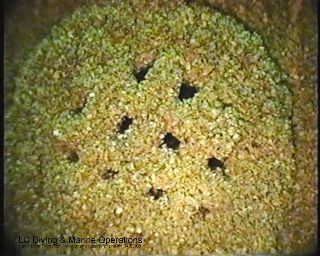Quagga Mussels on the Lower Colorado River
Davis Dam Activities
When Davis Dam was inspected in late 2007, mussels were found, but the colonization was not extensive. Since then, Davis Dam has experienced substantial colonization of its domestic water supply intake grate in Lake Mohave and domestic water supply line inside the dam and powerplant. The line provides water for drinking fountains, restrooms, air conditioning and other equipment. Heavy colonization of the dam's spillway gates has occurred also. This increased colonization has resulted in increased maintenance activities, but it has not affected the dam's power generation or water delivery functions. Reclamation is monitoring interior and exterior systems and features at Davis Dam throughout 2008 to gather data that could be used to determine future management actions. The monitoring plan includes using strings of steel plates suspended under water in the dam's forebay to monitor mussel colonization rates, replacing all 3/8-inch basket strainer screens with 1/8-inch screens, installing two "bio-boxes" to allow visual inspection of the domestic water supply lines, and semi-annual underwater inspections of exterior surfaces. 
Because colonization has occurred faster than projected, Reclamation's Research and Development Office in Denver, Colo. is presently developing a high-pressure water jet and researching other methods to clean out the domestic water supply line. In addition, Reclamation divers are periodically inspecting and recording the mussel mussel build-up on the dam's exterior surfaces. Underwater inspections of trash racks, gates and inlet structures have also been increased, from semi-annually to once a month. |
Webmaster: sha-lcr-webcomments@usbr.gov
Updated: June 2008

